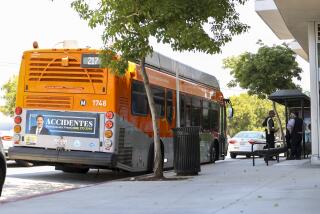Transit Zone Offers Hope for a Better Bus System
- Share via
Imagine your daily commute within or out of the San Fernando Valley five years from now. Is the picture a dream or a nightmare?
A lot must be done to prevent Los Angeles County from becoming one giant, idling parking lot. But there’s something happening right now in the Valley that could make the future of the region’s roads a lot brighter: the proposed San Fernando Valley transportation zone. The zone would overhaul Valley bus service and put in a better, cheaper, more efficient system. It would finally make local public transportation a viable option for car commuters and provide decent riding conditions for people who depend on their buses.
The current system, run by the MTA, is by all accounts badly broken. Buses are dirty, vandalized, hot and overcrowded. Sometimes they come on time, sometimes they don’t come at all. And, what’s worse, there’s not the route or schedule flexibility to give hundreds of thousands of daily commuters a real alternative to going it alone in their cars.
The transportation zone would go a long way toward changing that. Under the zone, routes and schedules could be revamped to address community needs and transit problems. Transit hubs could be set up to serve employers in major work centers, such as Warner Center, or the Valley’s ever-growing entertainment industry, manufacturing, high-tech and retail locales and schools.
Transfers between buses and bus lines could be seamless, painless and convenient. The money saved could be reinvested to further improve bus service. Best of all, the zone would be subject to local control, not the dictates of the MTA’s downtown bureaucracy. The zone would be governed and administered by an elected or appointed board, made up of residents of the participating Valley communities.
A citizens advisory committee appointed by our Valley-area City Council members studied the zone concept in detail earlier this year. The committee concluded that the zone is not only feasible, but a highly desirable means of restructuring Valley bus service. The Los Angeles City Council recently endorsed, by a 12-0 vote, the committee’s recommendation that the city proceed with the zone application process and encourage neighboring jurisdictions, including Burbank, Glendale, San Fernando, Calabasas and Agoura Hills, to join in persuading the MTA to create a Valley transportation zone.
When the application is submitted to the MTA, proponents will need to demonstrate that the MTA cannot provide adequate bus service in the Valley (this shouldn’t be difficult) and that the zone can do it better and for at least 25% less money. After a series of public hearings are held on the issue, the MTA board will vote on the proposal, and, if it is approved, the changeover to a transportation zone will begin.
Funded almost entirely by the MTA for the first three years, the zone will be evaluated in its third year of operation to see if it can keep providing better service while still saving at least 25% compared with MTA costs. Assuming the zone can so demonstrate (and there’s every reason to believe it can), it will be designated an “operator” and henceforth be on its own, serving local communities, meeting local needs and, best of all, guaranteeing local control of the bus system.
Who will benefit? All of us. Wouldn’t you prefer to zip across the Valley on a dedicated busway rather than figure what alternative route you need to take on a given day?
Wouldn’t you rather leave the car at home, or at a Park-and-Ride, when you know you’ll be able to catch a DASH commuter bus, shuttle or a safe, clean bus that will arrive on time, not pack you in like a sardine, and get you to your destination ready for the day? And don’t those people who are dependent on public transportation deserve decent conditions, which do not exist now?
The City Council’s political will for moving this critical issue forward seems to be present. Now it’s time for Valley residents and businesspeople to get involved. It’s our expectation that the more people look, the more they will like the idea of a Valley transportation zone. And the greater public support and participation in the process, the further the zone will go toward helping solve Valley transportation problems, which threaten our community’s quality of life.
More to Read
Sign up for Essential California
The most important California stories and recommendations in your inbox every morning.
You may occasionally receive promotional content from the Los Angeles Times.













